The Rise And Fall Of The '80s Cottage Cheese Diet
Ah, the 1980s. An era of leg warmers, neon spandex, and VHS tapes. Before kale chips and protein bars, there was the cottage cheese diet, a creamy-white relic of diet culture that somehow became a poster child for "health" long before we knew what gut bacteria were. But how did a lumpy dairy product become a dieting icon of a bygone era only to become weirdly cool again in the age of TikTok?
The cottage cheese diet actually had its first moment back in the 1950s, but it gained steam in the late '70s and early '80s thanks to a mix of low-fat obsession, magazine hype, and celebrity endorsements. Cottage cheese was marketed as a miracle food: high in protein, low in fat, and versatile. For weight-conscious eaters trying to dodge carbs and calories, it was the dream, at least on paper. You couldn't escape it. Glossy magazines of the era paired cottage cheese with pineapple rings or tomatoes on limp lettuce leaves and made it the star of recipes that were more punishment than pleasure.
But it wasn't love at first bite for many dieters. With the texture of chunky pudding and a blank flavor that was little more than salty and acidic thanks to the '80s obsession with low-fat-everything, it was the kind of food you ate in silence. Alone. Possibly while wearing a leotard. But as food culture evolved, so did our palates. The rise of international cuisines, the fat-is-back movement, and growing awareness around diet culture all helped push cottage cheese off the plate. It wasn't indulgent, exciting, or Instagrammable — just aggressively white.
The comeback curd
Fast-forward to now, and guess who's quietly climbing back onto the menu? Yep, cottage cheese is having a moment, this time with a makeover. Foodies are trying delicious new breakfast ideas with it, whipping it into high-protein dips, making even higher-protein egg salad, blending it into pancake batter, and folding it into scrambled eggs. Many new cottage cheese brands have also made it to market. But its comeback isn't about restriction. Instead, it's all about function.
Fueled by Gen Z's obsession with retro eats and a wave of modern rebrands (think small-batch, full-fat, and loaded with probiotics), the once-forgotten fridge staple is reclaiming the spotlight with a lot more style. With around 13 grams of protein per half cup and gut-friendly appeal, it fits into modern nutrition trends without the sad lettuce leaf. Plus, modern brands are largely more focused on flavor that lowering fat content. So if you see a tub in your fridge and flash back to a leotard-clad aerobics VHS, know you are not alone. But maybe, just maybe, it's finally time to give the curds another try.

